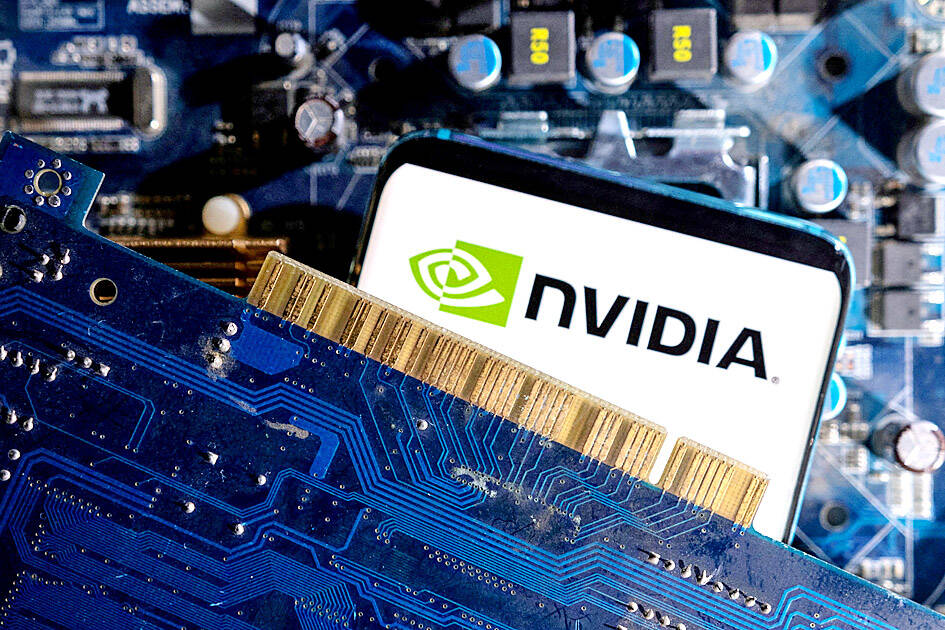The artificial intelligence (AI) mania sparked by Nvidia Corp’s sterling results has given a lift to Asia’s major chipmakers, but it has not closed the valuation gap with their US peers.
A Bloomberg gauge tracking Asia’s top semiconductor firms, including Taiwan Semiconductor Manufacturing Co (TSMC, 台積電) and Samsung Electronics Co, widened its under-performance against the Philadelphia Semiconductor Index this week. While the Asian index trades at 17 times forward earnings, the US measure is at 27 times, pushing the gap close to a record after Nvidia’s blowout revenue outlook reinforced investor conviction in the boom in generative AI use.
Nvidia’s 8 percent jump this week dwarfed gains of 2.1 percent for TSMC and 0.4 percent for Samsung. SK Hynix Inc, a key memorychip supplier for Nvidia’s AI processors, stood out in Asia with a 10 percent jump to a two-decade high. In total, major Asian chip stocks added US$31 billion in value this week, about one-10th of the gains in US names.

Photo: Reuters
Nvidia rallied as much as 16 percent on Thursday, adding about US$277 billion in market value. That was the biggest single-session increase in market history, beating Meta Platforms Inc’s US$197 billion gain earlier this month.
Nvidia chief executive officer Jensen Huang’s (黃仁勳) wealth jumped by US$9.6 billion to US$69.2 billion on Thursday, a gain that leapfrogged him ahead of US billionaire Charles Koch and Chinese bottled-water tycoon Zhong Shanshan (鍾睒睒) to 21st on the Bloomberg Billionaires Index.
Nvidia exceeded sky-high investor expectations with a revenue forecast that was more than US$2 billion ahead of analysts’ expectations.
However, lingering concerns about sluggish smartphone and PC demand from China have weighed on major players like Samsung and their stock valuations. Additionally, worries over possible US sanctions have also hurt valuation for Chinese stocks like Semiconductor Manufacturing International Corp (中芯).
Nvidia’s earnings are propelled primarily by AI applications, unlike TSMC, which also relies on a large smartphone business. While TSMC is Nvidia’s go-to chipmaker for fabricating its AI silicon, the “Nvidia earnings rise cannot directly translate into TSMC,” Bloomberg Intelligence analyst Charles Shum (沈明) said.
However, Templeton Global Equity Group sees investment potential in the Asian semiconductor sector’s relative undervaluation, as the region’s chipmakers could benefit from the AI boom more than what the market expects.
“AI is a secular trend, and Asia plays a pivotal role in its supply chain,” Templeton Global portfolio manager Ferdinand Cheuk (卓兆源) said. “Asia is the backbone for AI.”
Japan excels in providing the equipment and components required to build AI chips, while South Korea specializes in producing memory that integrates with AI chips, Cheuk said.
Taiwan provides both the AI chip foundries and downstream design manufacturers who assemble AI servers, he added.

Taiwanese suppliers to Taiwan Semiconductor Manufacturing Co. (TSMC, 台積電) are expected to follow the contract chipmaker’s step to invest in the US, but their relocation may be seven to eight years away, Minister of Economic Affairs J.W. Kuo (郭智輝) said yesterday. When asked by opposition Chinese Nationalist Party (KMT) Legislator Niu Hsu-ting (牛煦庭) in the legislature about growing concerns that TSMC’s huge investments in the US will prompt its suppliers to follow suit, Kuo said based on the chipmaker’s current limited production volume, it is unlikely to lead its supply chain to go there for now. “Unless TSMC completes its planned six

Power supply and electronic components maker Delta Electronics Inc (台達電) yesterday said second-quarter revenue is expected to surpass the first quarter, which rose 30 percent year-on-year to NT$118.92 billion (US$3.71 billion). Revenue this quarter is likely to grow, as US clients have front-loaded orders ahead of US President Donald Trump’s planned tariffs on Taiwanese goods, Delta chairman Ping Cheng (鄭平) said at an earnings conference in Taipei, referring to the 90-day pause in tariff implementation Trump announced on April 9. While situations in the third and fourth quarters remain unclear, “We will not halt our long-term deployments and do not plan to

‘SHORT TERM’: The local currency would likely remain strong in the near term, driven by anticipated US trade pressure, capital inflows and expectations of a US Fed rate cut The US dollar is expected to fall below NT$30 in the near term, as traders anticipate increased pressure from Washington for Taiwan to allow the New Taiwan dollar to appreciate, Cathay United Bank (國泰世華銀行) chief economist Lin Chi-chao (林啟超) said. Following a sharp drop in the greenback against the NT dollar on Friday, Lin told the Central News Agency that the local currency is likely to remain strong in the short term, driven in part by market psychology surrounding anticipated US policy pressure. On Friday, the US dollar fell NT$0.953, or 3.07 percent, closing at NT$31.064 — its lowest level since Jan.

The New Taiwan dollar and Taiwanese stocks surged on signs that trade tensions between the world’s top two economies might start easing and as US tech earnings boosted the outlook of the nation’s semiconductor exports. The NT dollar strengthened as much as 3.8 percent versus the US dollar to 30.815, the biggest intraday gain since January 2011, closing at NT$31.064. The benchmark TAIEX jumped 2.73 percent to outperform the region’s equity gauges. Outlook for global trade improved after China said it is assessing possible trade talks with the US, providing a boost for the nation’s currency and shares. As the NT dollar